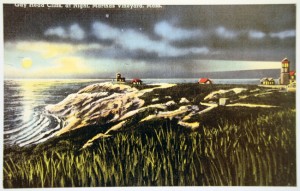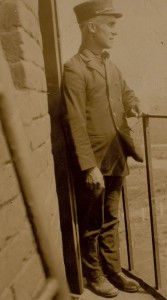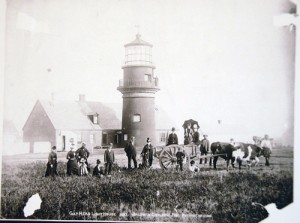The Gay Head Lighthouse was the first lighthouse constructed on Martha’s Vineyard. In 1796, because both islands were deeply involved in the whaling industry, maritime traffic had increased to the point that Peleg Coffin of Nantucket wrote his Congressman asking for a light to be erected at Gay Head. Secretary of the Treasury Alexander Hamilton was granted $570 by Congress for that purpose. In 1799 The Commonwealth of Massachusetts deeded two acres and four rods to the federal government for the site of the Gay Head Lighthouse. President John Adams approved the contract with Martin Lincoln of Hingham to build a wooden lighthouse structure with a keeper’s cottage and outbuildings. This authorization was to help facilitate safe passage for shipping traffic through the hazardous Vineyard Sound between the Gay Head clay cliffs and the Elizabeth Islands. In the area westerly of the clay cliffs is the infamous Devil’s Bridge, which is composed of a submerged shoal and rock formation. On November 7, 1799 the light was turned on for the first time. The light was most likely a “spider” lamp of several wicks in a shallow circular pan filled sperm whale oil. Ebenezer Skiff was the first appointed keeper. After the building was completed, Paul Revere provided some copper and tin used to augment the weatherproofing of the Light.
In 1844, the octagonal wooden light tower was moved back 75 feet from the eroding clay cliffs by John Mayhew of Edgartown at a cost of $386.87. By the early 1850s the tower was in disrepair and again threatened by the eroding clay cliffs.
1852 saw the Federal Lighthouse Board issue a 760-page report stating that Gay Head Lighthouse was “not second to any on the eastern coast, and should be fitted, without delay, with a first-order illuminating apparatus.” In 1853 lighthouse keeper Samuel Flanders reported to the Vineyard Gazette: “Gay Head is to have a new lighthouse, 5 or 6 rods back from the present one, a new dwelling house is also to be erected”. $13,000 was appropriated for the building projects, as well as to make improvements to the light apparatus.
In 1854 the light was upgraded to 14 lamps and larger reflectors. The previously dim Gay Head Light was now bright enough to be confused with the second order Fresnel lens that was in the Sankaty Light on Nantucket, and at least one shipwreck occurred. In August 1854 Congress approved $30,000 for the construction of a new brick tower to fit a first-order Fresnel lens, and a new keeper’s residence also made of brick. As a result, the existing 52 feet tall conical brick tower and dwelling were constructed by Caleb King of Boston in 1855 and the lamp was lit in 1856. The bricks used to construct the light were composed of clay harvested from the nearby cliffs or the nearby Chilmark Brick Works. It was equipped with a whale oil fired, first-order, Fresnel lens standing about 12 feet tall, weighing one and a half tons, and containing 1,008 hand-made crystal prisms, with a bright flash every 10 seconds. Before being shipped to the United States, the Fresnel lens commissioned for the Gay Head Light was exhibited at the 1855 Paris Exhibition of Industry, and won first-prize. At the time of installation, Gay Head was listed as one of the most important lighthouse locations in the United States. Therefore, it deservedly became one of the first lighthouses in the United States to receive a first-order Fresnel lens. After installation, the Gay Head Light received considerable publicity. This resulted in many tourists visiting the light via steamship and other transport systems of the period.
On May 15, 1874, the beam pattern was changed from just flashing white to three whites and one red, to distinguish Gay Head from all other lights along the East Coast.
1902 saw the replacement of the brick keeper’s cottage with a wooden structure after a number of unexplained illness and deaths had occurred in the brick dwelling.
Charles W. Vanderhoop, Sr., a member of the Wampanoag Tribe of Gay Head (Aquinnah), became the first Wampanoag keeper in 1920. He and assistant keeper Max Attaquin, also a Wampanoag, remained until 1933. The light has had a total of 18 principal keepers and 10 assistant keepers.
A high intensity electric beacon replaced the Fresnel lens in 1952. The Fresnel lens was donated to the Martha’s Vineyard Museum and was installed in a new tower on the museum grounds by the Coast Guard. By 1956 the Gay Head Light was fully automated and the keeper’s cottage was torn down.
From 1956 to 1985, the automated Gay Head Light was sparingly maintained by the United States Coast Guard. Due to US Coast Guard Congressional funding shortages through the 1970s and early 1980s, various lighthouses around the United States were designated for destruction because the structures were expensive to maintain, and no longer served as vital aids to navigation. This obsolete designation was precipitated by enhanced satellite GPS and other electrical maritime navigation aids. In the mid-1980s, due to United States Coast Guard funding shortages, the Gay Head Light along with two other Martha’s Vineyard lighthouses (East Chop Light and Edgartown Harbor Light) were listed for destruction. As in other similar lighthouse removal projects, the United States Coast Guard would dismantle or raze the existing lighthouse and, if deemed necessary, replace the light with a low-maintenance iron spindle structure top-mounted with a strobe light.
The three threatened lights on Martha’s Vineyard were saved through the objecting federal petition and Congressional testimony of Vineyard Environmental Research Institute (VERI) founding President William Waterway Marks, and VERI Chairperson John F. Bitzer, Jr. In 1984, VERI received the support of Senator Ted Kennedy and Congressman Gerry Studds during and after the Congressional hearings to save the three island lighthouses from being dismantled and/or razed. Following the Congressional hearings, the United States Coast Guard licensed the three lights to VERI in 1985 for thirty-five years. This lighthouse license gave complete control over the management and maintenance of Gay Head Light structure (except the aid to navigation) and its surrounding grounds. After receiving the lighthouse license, VERI undertook a series of fundraising activities that engaged the community of Martha’s Vineyard. The proceeds from the lighthouse benefits were applied to a major restoration of the Gay Head Light, and plans were made to open the light and grounds to the public.
The Gay Head Light was reopened to the public in 1986 for the first time since its closure in 1956. In 1986 lighthouse tours and public lighthouse sunset gatherings once again became available to the community and visiting tourists. Between 1986 and 1990, various Assistant Keepers were appointed by the light’s Principal Keeper, William Waterway Marks, including the appointment of Charles Vanderhoop, Jr., son of Charles W. Vanderhoop, Sr. (Gay Head Light Principal Keeper 1930-33).
Keeper Charles Vanderhoop, Jr. became renown for his lighthouse tours with island school children. Charles enthralled island children with his stories of being born and growing up in the lighthouse while helping his father during the 1920s and early 1930s. Charles also visited island schools where spoke to children and worked on lighthouse programs with teachers
In 1990, William Waterway Marks appointed Richard Skidmore and Joan LeLacheur as Keepers. In 1994, VERI transferred its license to the Martha’s Vineyard Museum. Richard and Joan became the Keepers for the Martha’s Vineyard Museum, and during President Barack Obama’s 2009 vacation on the island he and his family were given a personal tour of the lighthouse by Joan LeLacheur.
On April 8th, 2010 keeper Skidmore entered the Lighthouse grounds and found 40 feet of split rail fence missing. It had tumbled down the cliff face, because erosion had eaten away the soil and clay the fence posts were rooted in.
That event led to an investigation by Keeper Skidmore, funded by the Martha’s Vineyard Museum through funds granted by Town of Aquinnah tax payers, to determine if the Light could be protected in-place or if it had to be moved to safety.
On October 12, 2012, Aquinnah resident Elise LeBovit met with Aquinnah Board of Selectmen to declare the need to form a Committee to save Gay Head Light, based on information developed by Keeper Skidmore; including preliminary site visits with representatives from International Chimney, and her independent research into other communities that had faced a similar predicament. The selectmen voted unanimously to take her recommendation and form a Committee to Save the Gay Head Lighthouse.
On October 30, 2012, a Martha’s Vineyard Museum delegation comprised of David Nathans, who was then executive director, Betsey Mayhew, chief financial officer, Jim Richardson, board member and geologist, who had lent his expertise to the cause, Craig Dripps, chair of the Museum’s Lighthouse committee, and Keeper Skidmore— went to the Aquinnah Board of Selectmen and reported their findings about the need to save Gay Head Light by moving it.
Their prescription was that it would cost between 1-3 million dollars, that the clay buttress west of the Light pointed the way to a safe landing, and that International Chimney, and Expert House Movers, after 3 visits, had certified that it could be moved. For safety’s sake, the move needed to happen in 2015.
Those two appeals to the AQBOS underlined the need for action. In late 2012, a committee to save Gay Head Light was formed in Aquinnah by Elise LeBovit, who became the chairman. Beverly Wright later became chair.
Aquinnah resident Len Butler, a builder of fine homes, chaired the Relocation Committee.
The official fundraising campaign, headed by Mitzie Pratt and Meg Bodnar, began on June 21st, 2013 with the announcement that The National Trust for Historic Preservation had put the Gay Head Light on it’s 2013 list of America’s 11 Most Endangered Historic Places.
In February 2015, after months of discussion with several federal and state agencies, including the National Park Service, the US Coast Guard, the Department of the Interior, the State Historic Preservation Office, the Town of Aquinnah acquired Gay Head Light.

Getting ready to move. photo credit: Richard Skidmore
By the time of the move, just 2 years after the need was announced, 3.4 million dollars had been raised for the project. All 6 Island Towns had contributed substantial funds to the move effort, and there was $350,000 in grant monies. 1,000 individuals donated more than $2,000,000 to complete the project. Truly, it was an Island-wide effort.
Preparation of the site for the move began, and by May 28th International Chimney and Expert House Movers were ready to move the 400 ton brick Light.
By May 30th, 2015 the Light was 134 feet from where it had been built, its safety assured for well over 100 years.

before move

after move
On August 11th, 2015, Gay Head Light was re-lit at its new location. Public tours resumed under the direction of the Martha’s Vineyard Museum shortly thereafter. Meanwhile, restoration of the fragile clifftop began at the Light’s original site. Granite foundation stones, found during the excavation for the move were placed in a circle marking the spot where Gay Head Light had stood for 159 years. The circle’s center stone has a rusty ring that is the imprint of the Light’s center column. That was the foundation stone that bore the weight of the interior stairs and landings and the old Fresnel lens.
Following the move, the SAVE THE GAY HEAD LIGHT committee was disbanded, mission accomplished, and the Gay Head Light Advisory Board was formed to oversee the future needs of the building.
In June, 2016, new, child-proof railings on the brownstone balcony fabricated and installed by ViewPoint Architectural Metals replaced the original railings from 1856. The entry steps to the Light, and the stone retaining wall both received railings that match the balcony above.
By September 1st, 2016, the old site had been reconstituted, and the new Lighthouse Park, adjacent to Gay Head Light, was opened to the public.
In May, 2017, International Chimney began investigating a key structural area where the metal balcony and light room meet the brick. Those bricks were strategically removed to observe the condition of the inner courses. Where damage from water seepage was found it was repaired.
Also, the interior stairway landings were childproofed by the addition of historically accurate balusters again fabricated and installed by ViewPoint.
Care for this venerable monument will proceed, as there is approximately one-million dollars of structural and historical renovation needed for long-term preservation of the tower. Grants are being sought by the Town of Aquinnah Gay Head Light Advisory Board.
The recent announcement of a $57,500 matching grant from the Massachusetts Preservation Projects Fund insures that, in the Autumn of 2017, necessary brick work will be accomplished— the latest example of the Town of Aquinnah’s care for the Island’s preeminent maritime icon, Gay Head Light. KEEP ON SHINING!



